This post was prompted by recent comments in another thread in the Construction Techniques topic section. The topic was horizontally seamed steel roofing versus standing-seam. As an example of some of the variety exhibited here in Japan, I went out onto my veranda this afternoon and took these first six pictures:
This is my nearest neighbor to the north. The main house was built 4-5 years ago, and is roofed with the same kind of horizontal-seam steel (probably Galvalume) as our house. In contrast, the out-building below it is roofed with an inexpensive kind of standing-seam sheet metal called totan, generally rendered as galvanized or zinc-plated steel. In contrast to the newer Galvalume products, the surface of totan roofs requires frequent repainting.
View Image
A closeup of the standing-seam roof on the outbuilding. The brick red color is also fairly “standard” here.
View Image
Our neighbor to the east also has a conventional Japanese-style single-storey house with the same kind of standing-seam totan roof:
View Image
Just to the north of the house above, a relative of theirs has a house with mixed roofing style; the part on the right side is the original post-and-beam structure and is roofed in traditional clay tile. The section on the left was, I believe, added later, and appears to be roofed in horizontal-seam metal.
View Image
Pulling the zoom back a bit shows two more traditional houses in the distance at left and right with clay tile roofs:
View Image
Finally, to the northwest one can see a jumble of housing with equally varied roofing styles including traditional clay tile on a hip roof; standing-seam metal; horizontal-seam metal; and possibly a faux slate roof (the green, triangular roof at the right side); it might also be horizontal-seam metal roof, however. I should note that faux-slate style, called “Colonial” here, is also fairly popular.
View Image
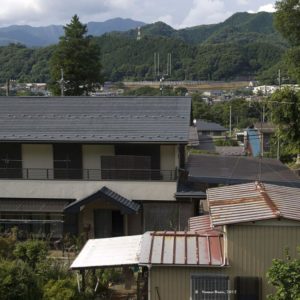
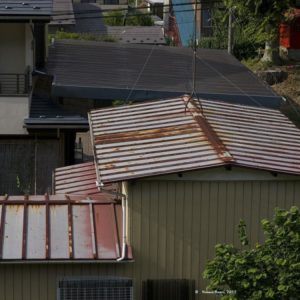
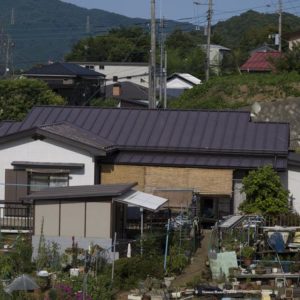
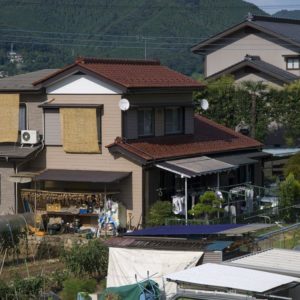

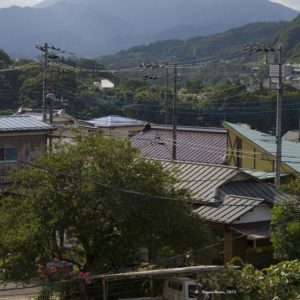





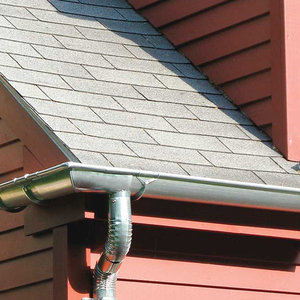













Replies
hok
thanks!
Your welcome, Cal.
You're welcome, Cal.
+1
An interesting study.
As a side observation, I'd say the Japanese are avid gardeners too.
The little town where I live is about an hour west of Tokyo, and most original inhabitants (not newcomers like me) have been at least half-time farmers forever. The town is in a valley formed by rather steep, low mountains on either sides of a river, so over 2,000 years or more the land has been terraced to form relatively small plots. In recent years as farmers age and youngsters move to the city, more and more land has been sold off for housing tracts, but those people with enough land inevitably continue to farm at least a bit. My piece of land is too small to allow much of a garden, and I'm usually too busy with my job or woodworking to take time for gardening. At least we're able to buy fresh vegetables at an unmanned vegetable sales booth a few meters down the road.
>>> an unmanned vegetable
>>> an unmanned vegetable sales booth a few meters down the road.
Haha! The sure sign of a tight-knit community. We've got the same here, though I wonder how long it will last. Pretty cool, I say.
Haha! The sure sign of a tight-knit community
I wish I could say that's the case; actually I've heard of little dishonesty by folks in the community, but there's a bit of theft by people driving through from the city (Tokyo).
Unmanned corn stands are not terribly unusual around here, and there's one honey stand that's often unmanned.
Honey, huh?
One of my neighbors began raising bees just a couple of years ago. Unfortunately, apiary pursuits seem to be getting harder recently; either climate change or something is making the bees less hardy, so he's having to do a lot of studying as he goes along. What has been really interesting is listening to my neighbor tell about all the natural enemies encountered by honey bees. Ants steal the honey, but the worst is the huge wasps (suzumebachi) that kill and carry off worker bees for food. Yikes!
Nice pictures
Thanks for sharing these nice pictures of a variety of roofs being used. Also you have provided good inforamtion and when backed with images is very helpful. These roofs look good and each are different from the other having their own advantages.
very imformative
I had a great time reading the topic and I found it interesting. This is such a beautiful topic that me and my friends are talking about. Thanks
However, in an attempt to ruin the above, I inserted some spam links below that some squirrel dog has deleted..............
Thanks for looking. I'm glad you and selenavaz found them interesting; I'm planning to post more pictures in coming months.
I have a standing seam roof
It is 24ga and 12" standing seam. It comes with a color fade warranty of 30 years - I am only 2 and a half years into the warranty period though so we'll see how well that turns out.
Why would the horizontally seamed roof not require as frequent repaints? The paint on my roofing panels is baked enamel. I'd assume that the reason the vertical seamed roofing "appears" to require frequent repainting is that either that
- the product you are seeing has been installed over 35 years ago and now requires repainting
- the quality of the roofing panels and the paint was previous a lower quality and required frequent repainting
- or the vertical seamed panels in Japan are a lower quality product and just require re-painting.
Of course this is really my hope as if my roof looks like that after 30 years I'll be more than a little upset !
Roof goes on very early too!
Hokuto
Not to highjack your thread but since you are talking about roofs in Japan...
I've been there a few times and noticed they like to put the roof on very early in the construction of new homes. Seems like a really good idea!
John